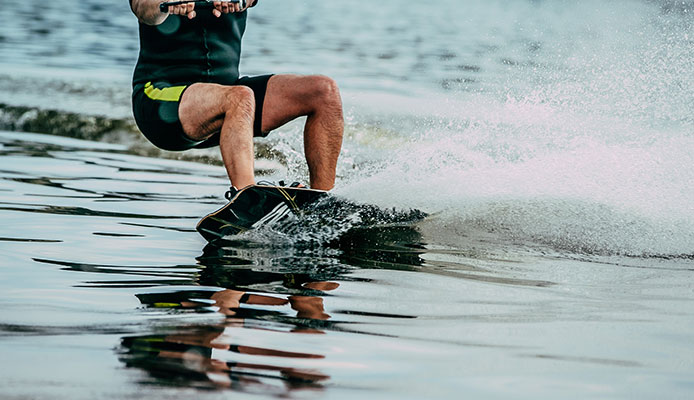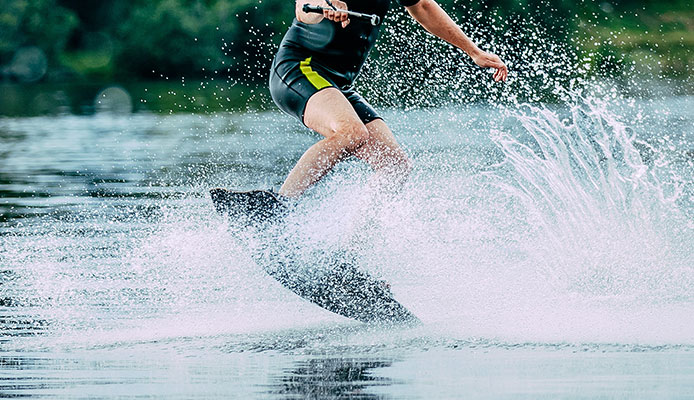
If you are a water lover, wake surfing can be your ticket to summer fun, and the rest of the seasons, too if you are willing to bundle up with a good wetsuit. Combining the tricks and airtime of wakeboarding with the awesome flow of surfing, wake surfing is one of the most enjoyable things one can do behind a boat.
For the first time, however, getting up and getting locked into the wave can feel like an uphill battle. However, with tips on how to wake surf, you should be able to shred the biggest waves in no time. In this detailed guide, we will take a deeper look at wake surfing how to.
Top Tips on How to Wakesurf
1. Pick the Right Boat
The best boat for wake surfing should feature the Forward Drive system. Instead of having the propellers in the rear, the boat will have dual, counterrotating propellers in front of its gearcase. This keeps the propellers away from the wake surfer, who will be much closer to the boat than when using wakeboards or water skis.
2. Get the Right Board
If you are just getting acquainted with wake surfing how-to, get yourself a board designed for beginners. Beginning wake surfers generally emphasize a predictable feel and stability, rather than pop and speed.
Therefore, the best wakesurf boards for beginners feature a larger surface area and a stable 3-fin setup. As an added benefit, beginner boards are often made with materials that have less buoyancy, which makes them sit lower in the water for added stability and slower speeds.
3. Get the Right Rope
Wakesurfing ropes are generally shorter and thicker, with a heavily padded handle. Some feature knots that help the wake surfers pull themselves into the wave’s sweet spot.
4. Get a Personal Floatation Device (PFD)
A good PFD helps you avoid drowning – you should wear it even if you excel at swimming. A well-fitting life jacket should work well for any wake surfer. When choosing a PFD, look for one with bright colors – brighter colors make it easy to spot downed riders.
5. Wear a Wetsuit
When learning the basics of wake surfing how-to, it is always a good idea to wear a rash guard or a wetsuit. As a beginner, you are likely to spend more time in the water, which can easily get chilly. More coverage also protects you from the falls you might take.
You might also like: How To Install Wakeboard Tower
6. Scope Out a Good Spot
When you get to the ocean for your wake surfing session, take a couple of minutes to find a perfect spot. Ideally, this will be an area that offers a clear and easy path for your ride. Avoid areas that are populated with other boaters and/or swimmers.
7. Start Slow and Be Patient
When learning how to wakesurf, you need to relax and allow your boat to do the work. While this can be frustrating advice for people who are very new to wake surfing how to, it can help you avoid falling in the water.
Getting started is all about your setup and patience. Sitting in the water, with both feet resting on your board, you will pressure the heels into the wakesurf board, so it flips up to your feet as the wakesurf boat pulls you up.
Once your feet are on the board, remain patient, and bend the knees as you come into the crouched position, leaning into your rope as your weight shifts over the board’s top. The moment you are fully over your board, you can go ahead and stand up gently.
8. Learn When to Drop the Rope
Once you get into the wave’s pocket, the wave’s push should be enough to keep you riding – you won’t need the handle to pull you along. When letting go of the rope, having the right posture is the most crucial first step – if you are all scrunched up, you will not be able to freely move around, positioning your board in the wave. Ensure that you are standing up straight and you aren’t bent over at your waist.
Once you feel comfortable enough surfing with a slackline, you can go ahead and let go of the rope. Either throw your rope directly back at your boat, or across the other side of your wave so that you can avoid getting caught up within it.
9. Control Your Speed
To control your speed, you will need to change the way you weight your feet. In essence, the front foot will become your gas pedal while the backfoot becomes your brake pedal. To speed up after catching the wave, simply pressure the front foot. To slow down, shift more weight to your back foot.
10. Fall Safely
When learning how to wakesurf, falls are inevitable – but there are various things one can do to make them easier and safer. When you are about to fall, try to avoid preemptively jumping into the water and instead allow yourself to fall in gently.
Once in the water, push your arms above your head to avoid knocking yourself into your board, should it float above your head. The PFD should help you float up.
FAQs

Q: How Do I Get Better at Wakesurfing?
Much like skiing and other sports, getting better at wake surfing takes a lot of practice. Once you get the basics of wake surfing how to, go riding with people who are more experienced than you. You can take advantage of the wake surfer’s advice.
Q: How Do You Get Air on A Wakesurf?
Speed is the key to getting air when wake surfing. You can gain speed by either driving your board down the line on the wave’s top or by pumping. With enough speed, you should be able to get some flight time with your board.
Q: Is Wakesurfing Easy?
Wakesurfing is generally easier to learn since the boat moves very slowly, usually, not more than 12mph. Also, since the rider is so close to the boat, he or she can start just behind the boat and end up on top of a wave – this means that catching waves is much easier.
Q: How Can I Practice Wakesurfing At Home?
To practice wake surfing at home, you will need a surf training balance board to help you mimic real wake surfing. To strengthen your legs, do deep squats on the balance board. You can also work on your balance by jumping up and landing on the balance board carefully.
Globo Surf Overview
A wet and wild pursuit, wake surfing is easier to master and enjoy than both wakeboarding and waterskiing. Taking place at an average speed of 10 mph, wake surfing wipeouts are generally easier on the rider’s body. This guide carries the tips you will need when learning how to wakesurf. Be sure to practice with experts so that you can get some pointers on how to avoid common mistakes.

